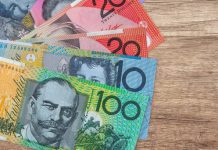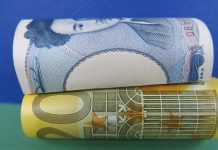The US dollar extended its recent losses on Friday amid continued uncertainty on the US political front and some dovish comments from St. Louis Fed President James Bullard. The policymaker acknowledged the elephant in the room, indicating that US economic data have been relatively weak since the March FOMC meeting. He added this suggests that another two rate hikes this year as currently indicated by the ‘dot plot’, may be overly aggressive.
Even though Bullard is a well-known dove and a non-voter this year, his comments still raise doubts as to whether a June rate hike is indeed as likely as market pricing currently suggests (78% according to the Fed funds futures). Therefore, we believe that the focus will now turn to the rest of the Fed speakers this week, as well as the FOMC minutes on Wednesday, as investors try to gauge whether that probability is realistic, or overly optimistic. In that respect, Fed Board Governor Lael Brainard’s comments tomorrow could prove critical for market expectations, as she is a permanent FOMC voting member and her views tend to be in line with the thinking of most of the Committee.
As for the dollar, we think that it could remain on the back foot, at least until Brainard speaks tomorrow. EUR/USD continued to gain on Friday, breaking above the resistance (now turned into support) barrier of 1.1170 (S1), before finding fresh sell orders near the 1.1240 (R1) territory and subsequently retreating somewhat. The price structure on the 4-hour chart still suggests a short-term uptrend and as such, we would expect the bulls to seize control again soon and aim for another test near 1.1240 (R1). A clear break above that level could set the stage for extensions towards the next resistance of 1.1300 (R2).
Brexit Secretary warns UK will abandon Brexit talks if EU demands divorce bill
The British pound opened with a modest negative gap this week, following comments from Brexit Secretary David Davis on Sunday. Davis warned the UK will walk out of Brexit talks should the EU continue to demand EUR 100 billion as a divorce bill, and added he regards even ‘EUR 1 billion as a lot of money’. Considering that the issue of the divorce bill is expected to be the first item on the Brexit negotiating agenda, Davis’s uncompromising remarks may have been interpreted as raising the likelihood for no deal and thus, a ‘hard Brexit’.
Moving forward, we think that sterling will probably remain very sensitive to political developments ahead of the General Election. The latest election opinion polls show the Conservatives securing 47% of the total vote. In our view, fresh polls that show the Conservatives extending their lead could prove positive for the pound, on speculation that Theresa May will be able to negotiate a better Brexit deal with the increased domestic influence she will gain. On the other hand, polls that show the party gaining less than the anticipated 47% may prove negative for the currency. Finally, we think that incoming polls are likely to move the pound more aggressively than before, considering that polls just two weeks before Election Day may bear more significance in the eyes of investors.
GBP/USD traded higher on Friday, breaking above the resistance (now turned into support) level of 1.3000 (S1) to hit resistance at 1.3040 (R1). The pair opened with a negative gap this week below 1.3000 (S1), but recovered some of its losses in the following hours and at the time of writing, it is trading marginally above that level. The short-term bias is to the sideways in our view. Bearing in mind that Cable has been range-bound between 1.2850 and 1.3040 (R1) since the 27th of April, we think that the pair is likely to remain near key technical territories and wait for fresh developments surrounding the election. New polls that show the Conservatives extending their lead could cause the rate to surge and aim for another test at 1.3040 (R1), where a decisive break could pave for the way for the 1.3100 (R2) barrier.
Today’s highlights:
During the European day, the economic calendar is empty, with no major indicators due to be released.
We have three speakers on the agenda: Philadelphia Fed President Patrick Harker, Minneapolis Fed President Neel Kashkari, and ECB Executive Board member Jens Weidman. Following Bullard’s aforementioned comments, we think that market participants are likely focus on Harker and Kashkari, considering that both are FOMC voting members this year.
As for the rest of the week, on Tuesday we get Eurozone’s preliminary manufacturing and services PMIs as well as Germany’s Ifo survey, all for May. On Wednesday, all eyes will be on the Bank of Canada rate decision. The forecast is for the Bank to remain on hold once again. We think that the tone of the meeting statement is likely to be even more cautious than previously, following the recent tariffs from the US on Canada. We also get the minutes of the FOMC’s May policy gathering. On Thursday, the highly anticipated meeting between major OPEC and non-OPEC oil producers will take place in Vienna.
Finally on Friday, Japan will release its CPI data for April, while from the US, we will get durable goods orders for the same month and the 2nd estimate of Q1 GDP.
EUR/USD

Support: 1.1170 (S1), 1.1100 (S2), 1.1070 (S3)
Resistance: 1.1240 (R1), 1.1300 (R2), 1.1340 (R3)
GBP/USD

Support: 1.3000 (S1), 1.2950 (S2), 1.2900 (S3)
Resistance: 1.3040 (R1), 1.3100 (R2), 1.3150 (R3)













